One of my good friends has been bringing me Banh Da Lon (Vietnamese steamed layer cake) from her favorite bakery in Orange County for the past few months… since I was able to figure out Banh Bo Nuong (Vietnamese Honeycomb Cake), I know she really wants me to figure this one out too! I’ve tried… multiple times… and while I’m pretty happy with the results, I don’t think it will ever be exactly like the one she loves from Van’s Bakery in Westminster. They must have a super secret method or recipe… and I just can’t duplicate it. BUT – I think the recipe that I finally figured out (after so many attempts my husband doesn’t ever want to see or taste Banh Da Lon ever again) is pretty good in it’s own right. It’s not the same as Van’s… but I think it’s really good (if I do say so myself!), and am really happy with the results.
Banh Da Lon is a steamed cake, made mostly from “tapioca starch” (or “tapioca flour” – it’s the same thing). In texture, it’s almost like a layered jello with a slight mochi-like feel (not as chewy as mochi, but somewhere between mochi and jello). The green layers are flavored with pandan leaves (Pandanus amaryllifolius) which can be purchased fresh or frozen from Vietnamese or Chinese markets. Pandan leaves have a very unique fragrance – similar to vanilla, but better! It is best if you use fresh leaves – you can make do with pandan extract alone – but the result won’t be quite as good. I do like to add a little bit of pandan extract to give a brighter green color to the Banh Da Lon, even when I’m using the real leaves. The yellow layers are flavored with yellow (peeled split) mung bean. Most of these ingredients can be found in an Asian supermarket (Vietnamese or Chinese), or online.
Banh Da Lon Batter:
- 2 c. Tapioca Starch / Flour
- 1/2 c. Mochiko Sweet Rice Flour (Koda Farms brand)
- 1 3/4 c. sugar
- 1 can coconut milk
- 1 tsp. salt
Pandan water:
- 1 c. water
- 15 Pandan (“Screwpine” or “Bay Thoy”) leaves (fresh or frozen)
- 1/2 tsp. Pandan Flavoring Paste (optional)
Mung Bean mixture:
- 1/2 c. dry peeled (split) yellow mung beans
- 2 1/2 c. water
1. Simmer the mung beans in water on medium-low heat for 30 minutes until the mung bean is soft and the water mostly absorbed. (You can add more water bit by bit if needed.)
2. Allow the mung beans to cool, then blend into a smooth paste with food processor. You should have about 1 c. of paste.
3. Wash 15 pandan leaves. Chop roughly, and place in a small saucepan with the water. Simmer for 5-10 minutes on medium-low heat, until the water is reduced to 1/2 c. Cool slightly. (If you don’t have enough liquid, add water to increase the liquid volume to 1/2 c.)
4. Blend the pandan leaves/water mixture in a blender for 30 seconds.
5. Strain the pandan mixture into a measuring cup. Discard the leaf paste, and reserve the green pandan water. (You should have about 1/2 c. pandan water – if not, add a little water to make it 1/2 c.)
6. Sift the tapioca starch, rice flour, and salt in a bowl.
7. Mix the coconut milk and sugar in a small saucepan. Heat gently, while stirring, until the sugar is fully dissolved. Cool slightly.
8. Mix the warm coconut mixture into the dry ingredients in 3 doses, whisking in between each addition. You should have about 3 1/2 c. of batter.
9. Divide the batter – put 2 c. of batter in a bowl and mix with the 1/2 c. green pandan water (add pandan extract at this point if desired). Put the remaining 1 1/2 c. batter in another bowl, and mix in the 1 c. mung bean paste.
8. Place a greased 9 inch cake pan in a steamer (for easy removal, line the cake pan with non-stick foil), and once the water is boiling, add about 1/3 of the green mixture – allowing it to spread out into a thin layer over the bottom of the cake pan. Steam for 4 minutes.
9. Once the first layer is firm, add 1/2 of the yellow mung bean mixture. Spread this layer over the green layer and steam for 4 minutes. Repeat this process, steaming each layer 4 minutes at a time until finished. Once the last 4 minutes is up, steam the entire cake another 5-10 minutes. (You should end up with 3 green layers, and 2 yellow layers sandwiched between the green.)
10. Remove the cake from the pan, and slice. (I used a wavy Crinkle Cutter Knife that I got on Amazon, but I’ve also seen it for less than $5 at Vietnamese markets.) For easier slicing, rub the knife with a small amount of canola oil. Serve warm or at room temperature. Cover with plastic wrap to store. Banh da lon does not stay fresh for very long… so plan to eat it all within 2-3 days.

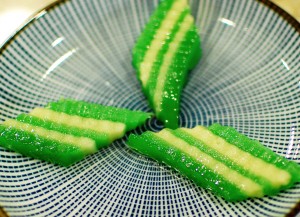
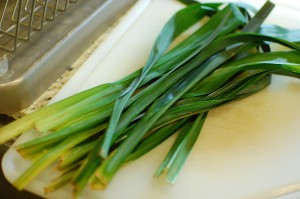
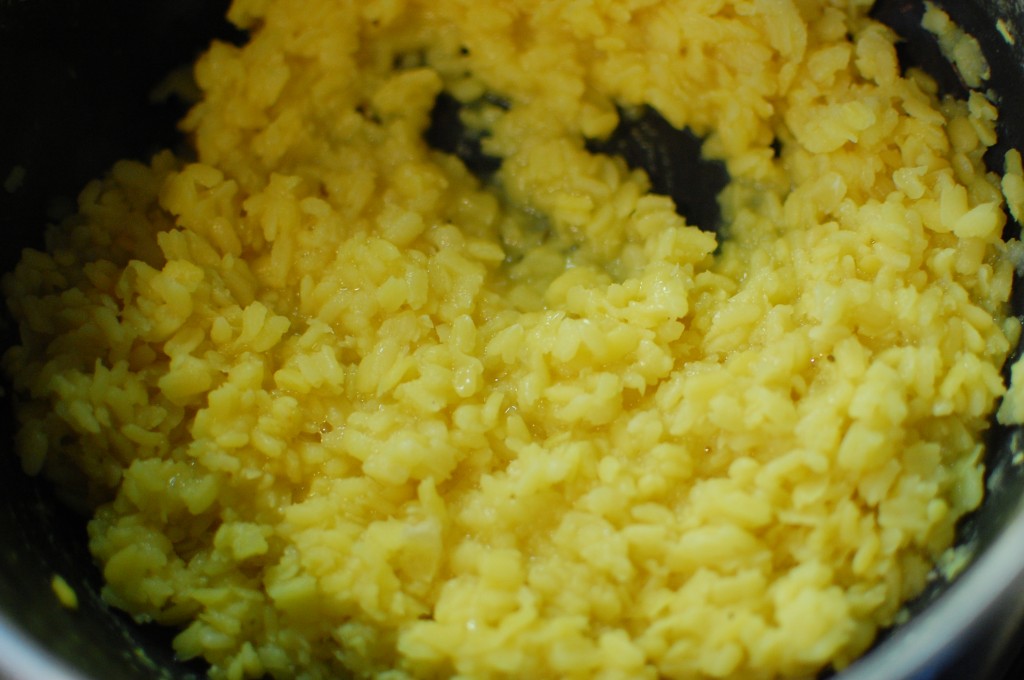
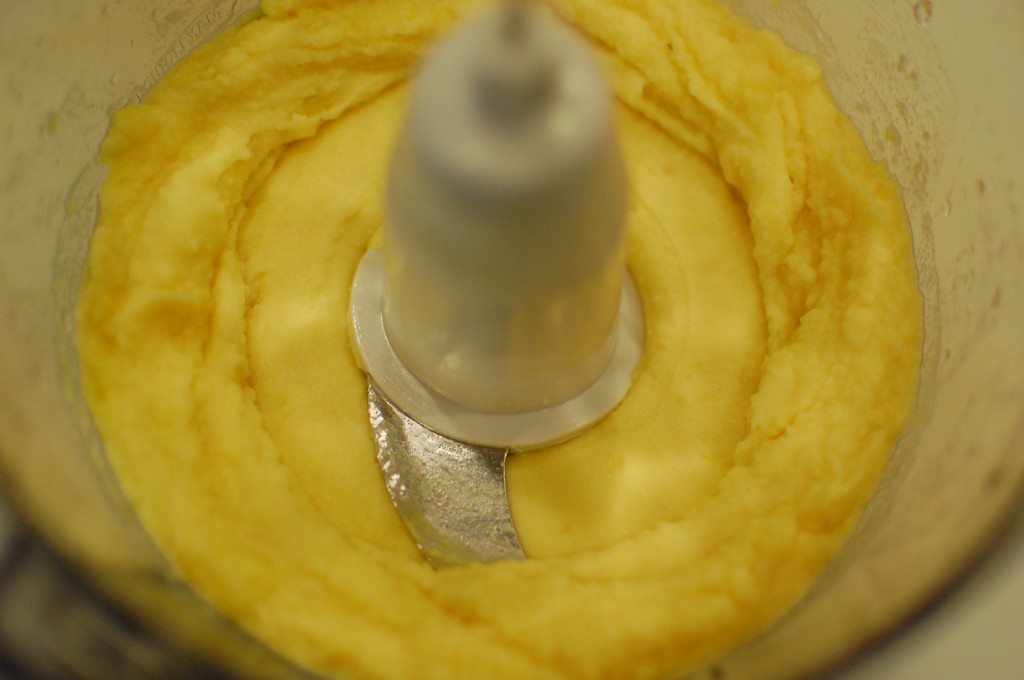
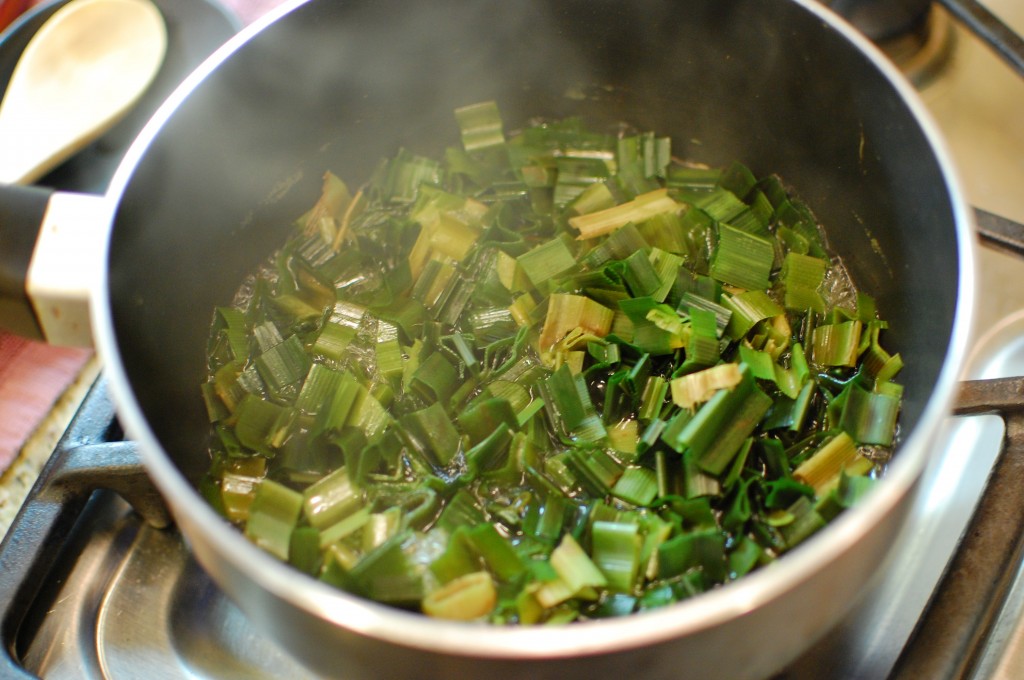
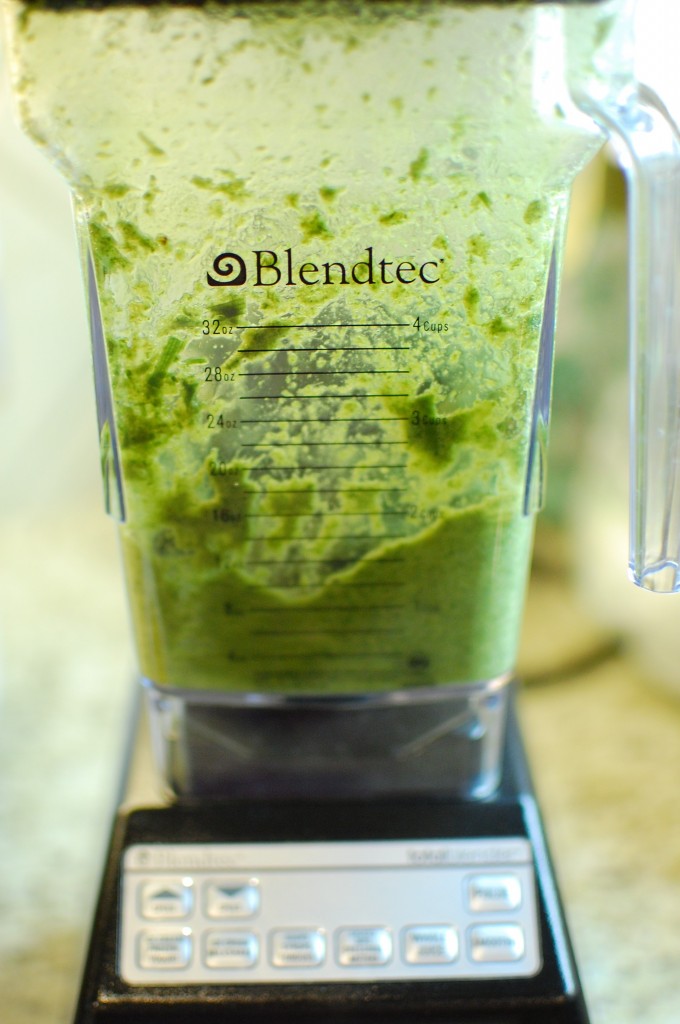
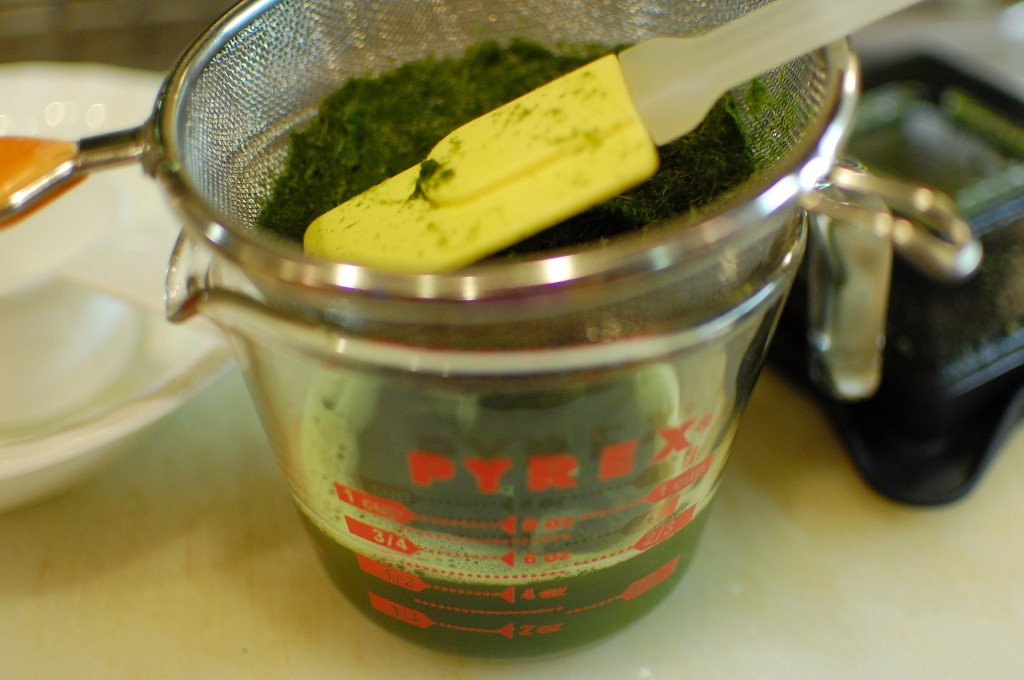
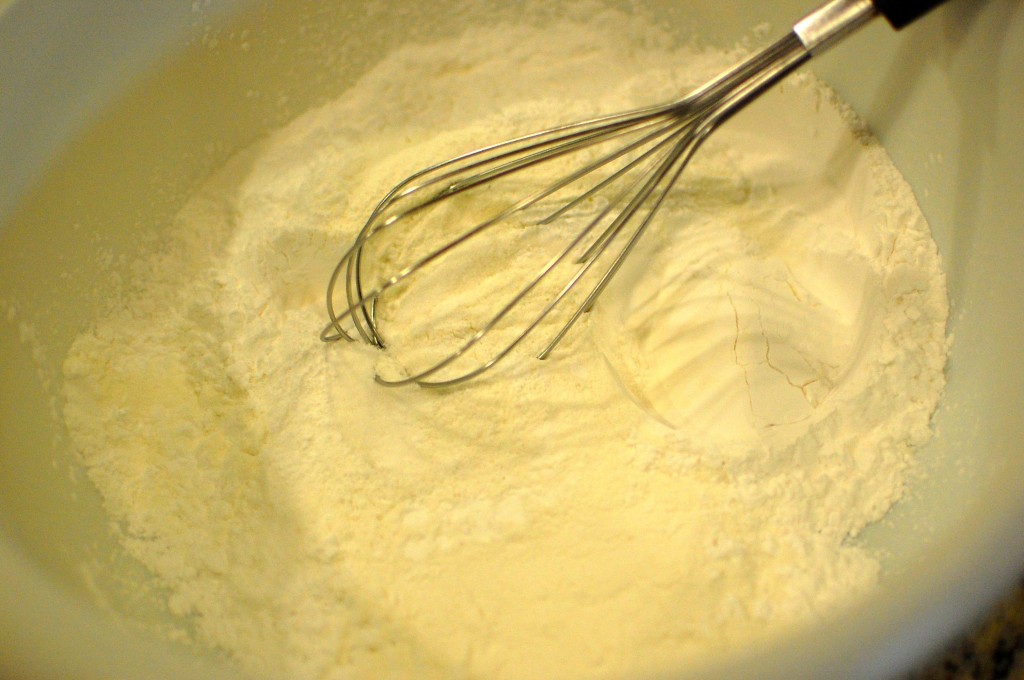
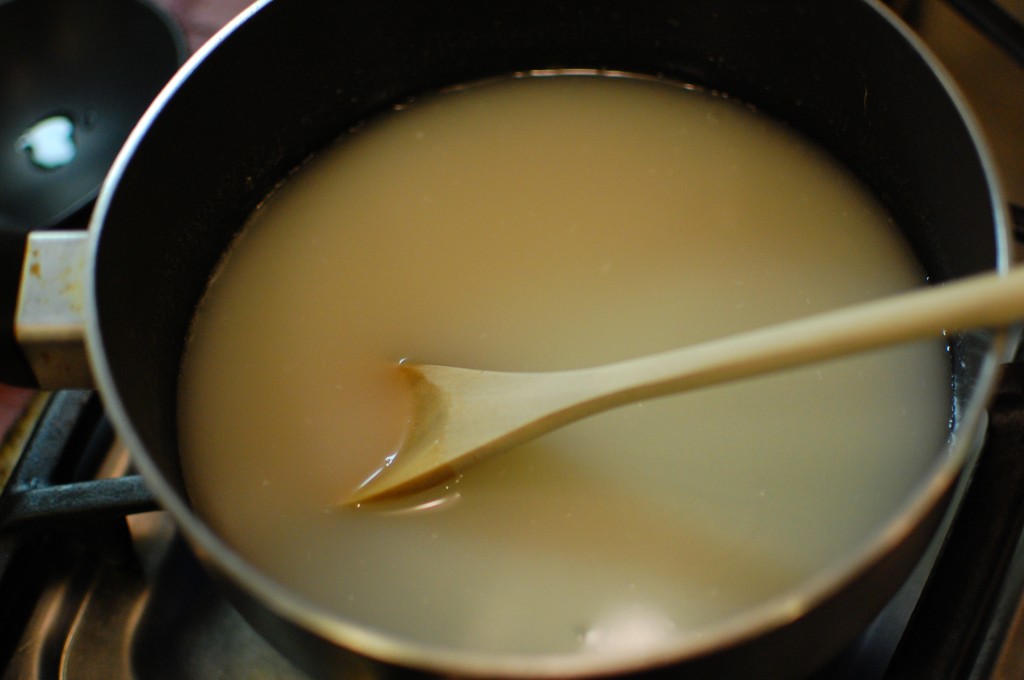
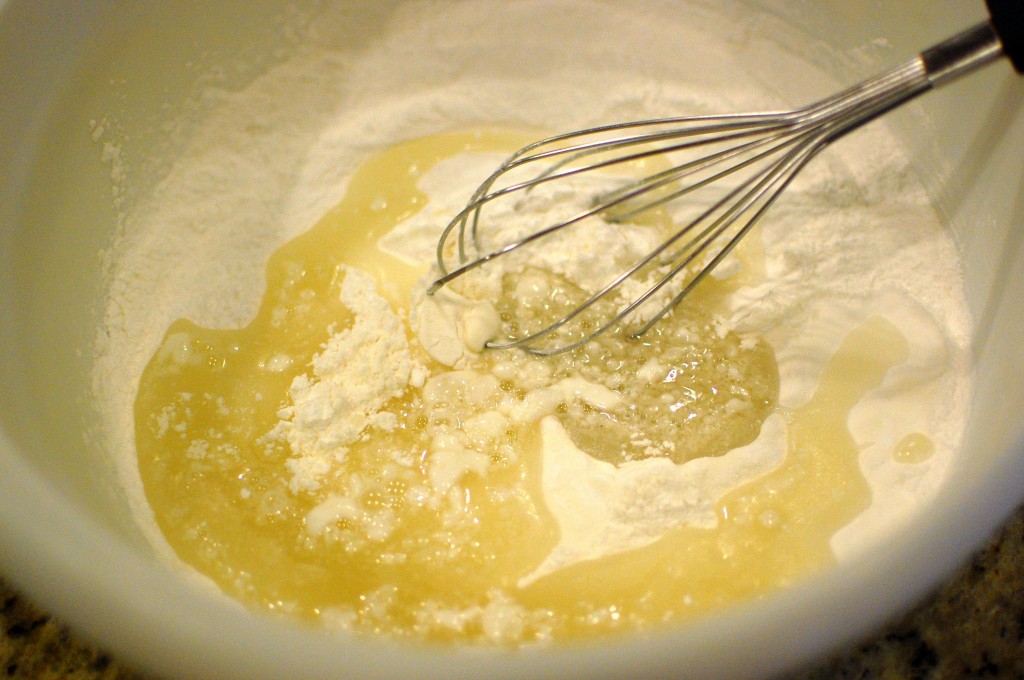
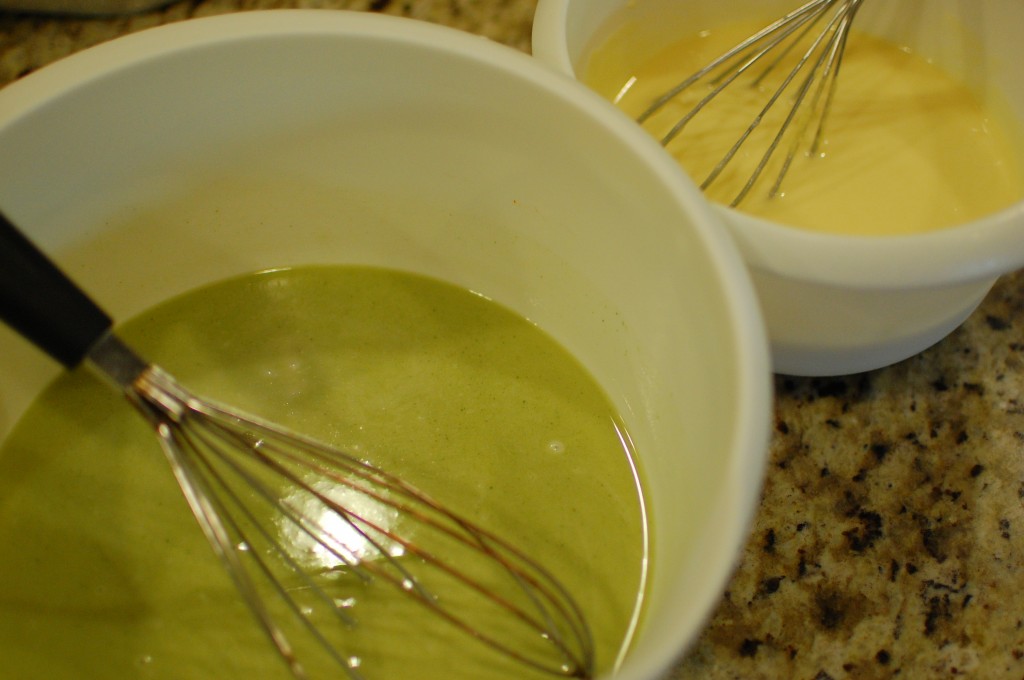
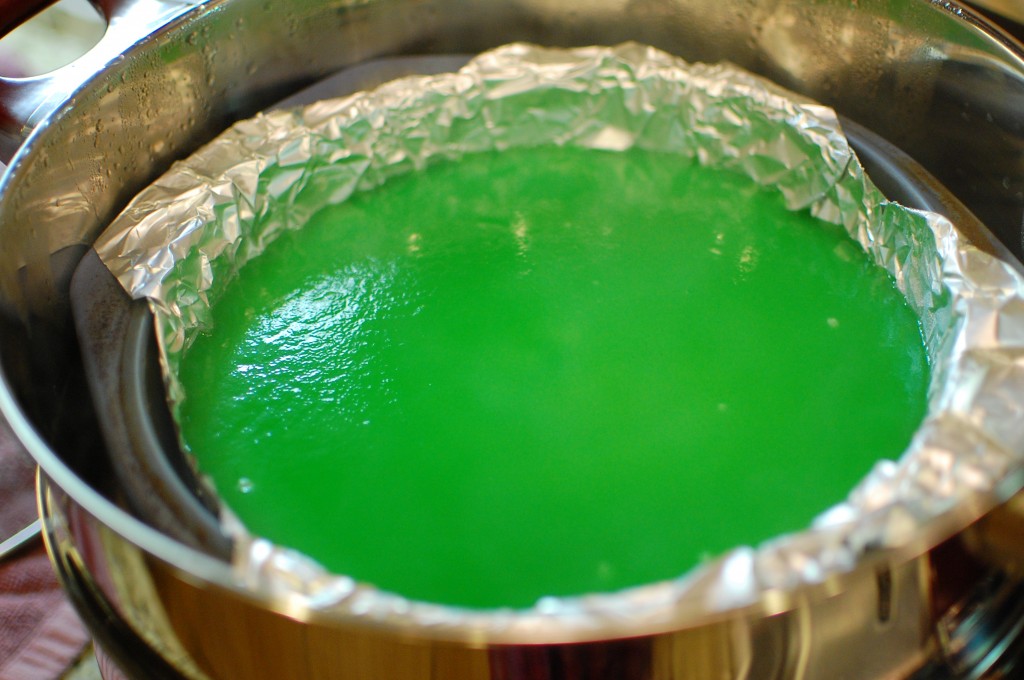
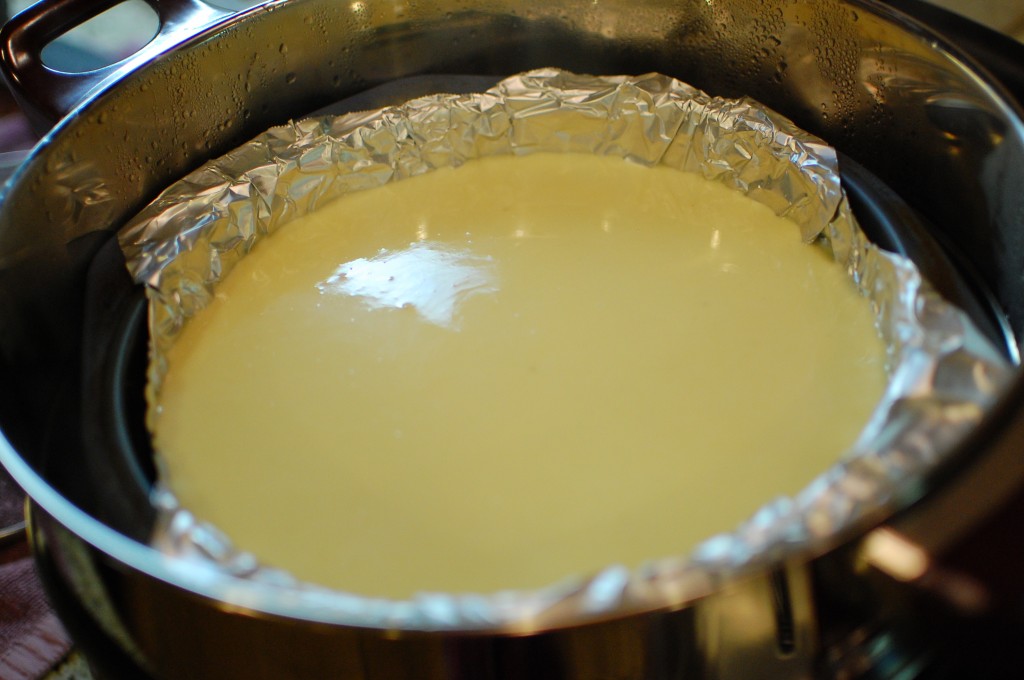
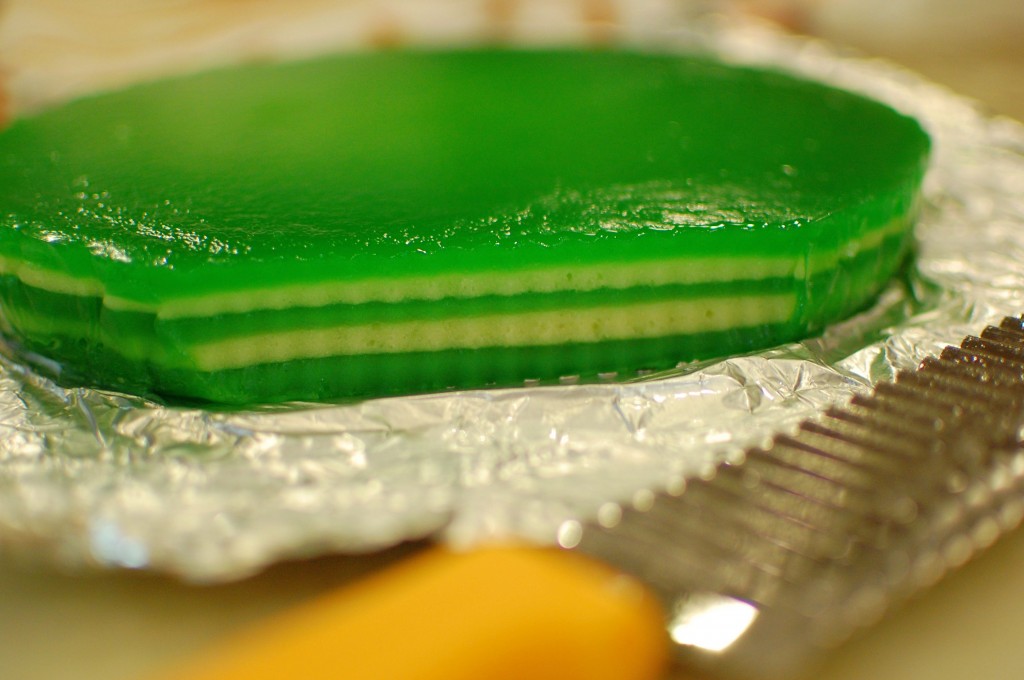


Hi Mika,
What is the thickness of the batter like? I make the cake today. But the pandan batter seems rather thin after I add the 1/2 cup of pandan liq and the mung bean batter seem rather thick after I add in the mung bean paste. So I end up adding a bit more batter to the pandan part and a bit more water to the mung bean part. Just hope I didn’t under cook it because I didn’t read your direction carefully. The last layer I cook for 7 minutes but didn’t add another 5-10 minutes at the end like you mentioned
Hi Amy,
Once mixed, the pandan batter will be thinner than the mung bean batter – this is normal, and your end result will turn out fine. Don’t add any extra water or change the ratio of the batter – otherwise the final cake might end up too soft.
The cake turned out quite good. Just the right chewy texture. I might have to add a bit more pandan extract next time because I can’t quite taste the pandan flavor although I’m using the frozen leaves. Thanks for posting the recipe. My next try will be your” banh bo nuong”.. One of those cake that is so easy yet so hard to bake
Hi Amy! Glad it worked out! I think for the best flavor, fresh leaves are best… but if you can’t get them, then frozen + more extract should work fine!
Hello, lovely recipe! I tried making the pandan leaf extract today but it turned out quite bitter and didn’t smell like pandan anymore! Do you think I overcooked the leaves?
I’m not sure – how long did you cook them? You only need to cook the leaves for a short period of time – enough for them to soften and the water to reduce… somewhere between 5-10 minutes. It was pretty quick (about 5 min) on my stove. How many leaves did you use? I could see the flavor becoming too strong if you use too many leaves… but also keep in mind, once you mix the water with the rest of the ingredients, the flavor gets diluted so it may not seem as strong once you are completely done.
Hi Mika! Gee, I’m so glad I found your website–I’ve been Googling Banh Da Lon recipes but they’re all in grams! (But yours is in cups, yay!)
I was wondering, if I’m going to use pandan extract, how many teaspoons of the extract should I use (in replacement of the real pandan leaves)?
Thanks Mika!
Love,
Ann
Oops! Sorry Mika, I guess it’s 1/2 tsp? I got too excited to make this that I didn’t see the 1/2 tsp pandan paste >~<
How many mL is in one can of coconut milk? Thanks
One can of coconut milk is 400mL. Hope this helps!
What if we don’t have pandan leaves but have the can with juice already? Can we use that instead and I think it’s thinner than the one you have to do. Please let me know if we could substitute it. Thanks
I don’t know. I’ve never used the can with the juice before. Maybe try it and see how it works out?
In my recipe, once you strain the pandan mixture, the green water is pretty thin – it’s not thick at all.
I used 1/2 cups of the pandan juice from the can and mixed in 1/2 teaspoon of the pandan extract with the pandan juice; which turned out perfect so give it a try
so give it a try
When we made it, it was extremely sticky and had to be pulled apart. What are we doing wrong?
It is supposed to be sticky… that’s the texture. If you find that it is sticking to the steaming pan, you may want to line it with greased non-stick foil for easy removal. If your texture is overly sticky, you may not be steaming it long enough – also check to make sure that water is not dripping onto the top of your cake while it is cooking.
Hi Mika,
Where I can buy Mochiko Sweet Rice Flour (Koda Farms brand) ?
thanks
Hi There! It depends on where you live. Typically, I can find Mochiko Sweet Rice Flour in the “Asian” section of the regular supermarket, here in California. You can also find it on the “flour” aisle in any Asian (Chinese, Japanese, Vietnamese, or Korean) supermarket.
If all else fails, you can buy a 12-pack online:
http://www.amazon.com/Koda-Farms-Mochiko-Sweet-Flour/dp/B00CYMBMTK/ref=sr_1_6?ie=UTF8&qid=1373863044&sr=8-6&keywords=mochiko
Hi Mika,
I need the ingredients in grams, do you think you can send it to me?
Thanks,
Ann
I’m sorry, I didn’t measure by weight – I measured by volume.
Hi Mika,
By 3 doses, do you mean to pour the coconut milk three times but whisk it in the middle of each?
Yes. Mentally divide the coconut mixture into thirds. Pour 1/3 of the coconut mixture into the dry ingredients, then whisk. Then add the next 1/3, and do the same. The add the final 1/3, and do the same. The reason to do it in batches is to get the mixture combined without too many lumps – it’s easier to do it if you start with a smaller amount of liquid then add to it.
Hi Mika,
What kind of steamer do I put it in? Or do I have to buy it? Can I make the steamer equipment myself? Like, is it a pot kind of steamer?
Just use a regular chinese style steamer pot – you know the kind where a steaming basket is set above boiling water with a lid?
3-Tier Chinese Steamer
Thanks so much for this recipe. I’ve been dying to make this. I’m not sure if you answered this but about roughly how many cups or whatever is 15 pandan leaves? Thanks again!
I’m not sure how many cups… my guess would be about 1 cup if you squashed the leaves down into the cup and packed it tightly, give or take.
Why bother with panda leaves when you get just the same result using Panda Pasta? I never use the leaves. Just start by using a quarter teaspoon of panda pastart + adjust amount according to color depth required.
Obviously, you don’t “have” to use real pandan leaves if you don’t want to – you can substitute with an equal amount of water + pandan extract. However, much like the debate between using actual vanilla bean pods and vanilla extract – some people find that the flavor from using real pandan leaves is superior over just the extract alone. It’s all to your taste.
I tried your recipe & it was a success! The best one I’ve encountered so far I have used other recipes in the past but found it to be too sticky or too rubbery to my taste. I was wondering if you have experiment it w the glutinuous rice flour (easily found at Asian’s supermkt) vs. the Koda Farm brand. They seems to basically be the same.
I have used other recipes in the past but found it to be too sticky or too rubbery to my taste. I was wondering if you have experiment it w the glutinuous rice flour (easily found at Asian’s supermkt) vs. the Koda Farm brand. They seems to basically be the same.
Thanks for the feedback, Gena! No, I haven’t tried other brands of Glutinous rice flour… I’m a creature of habit, so if I need it… I always buy the Koda farms brand (which is easiest to find if you are shopping at a Western style supermarket).
I tasted this banh da lon near in my place here in the philippines. ,when i tried it its really taste good , so chewy and shiny in color. She said her mother is a vietnamese, i asked her if she could teach me but she refused that even her own husband are not allowed to see how she cook it, i search in youtube and tried it. Unfortunately, i didnt get the consistency, or the texture that i tasted from that lady . The one i did is hard not to sticky and chewy, is that because of too much tapioca flour? Or should i omit the rice flour? What if i omit the rice flour and only use cassava flour, would it make a difference? I want it so chewy and soft…can you help me ls? Thanks
I’m sorry, you are going to have to experiment with different proportions. I’m not sure why yours came out hard, mine usually comes out soft and chewy – did you use my recipe, or are you talking about a different recipe you found on youtube? Maybe try my recipe instead (as written) and see how it turns out for you?
Mine turn out pretty good too! But I forgot to cook it for that extra 5-10 mins at the end! It’s been cooling down for 2hrs now. Can I re-steam it?? Cause the middle part is super sticky.. Not cook thoroughly?
I’m not sure. It might take a bit longer than that to get back up to temperature. If it’s undercooked and not edible, it wouldn’t hurt to try re-steaming it.
I was looking for a food item that I could make, to take with me to visit my mom’s friend tomorrow. I looked everywhere for a dessert and came upon this recipe. I made it today and it turned out great! Thanks so much
I couldn’t find pandan leaves at my asian supermarket, however, they had pandan syrup. I put in 1 tsp instead and it turned out well.
Thanks again!
Glad it worked out for you.
Good morning: I have a traditional (bamboo?) steamer basket that sits in a wok, but no cake pan. Do you think I could simply line my steamer with nonstick foil and put the batter directly into it?
I don’t see why not? You can certainly experiment and try it! Good luck!
Hi Mika!
I don’t have any pandan leaves or extract to make this lovely Vietnamese classic. How would I go about making a coffee version of this?
I’m not sure if coffee flavor would go well with coconut… If you want to try it though, substitute 1/2 c. espresso for the 1/2 c. pandan liquid in step 5.
Otherwise, maybe try using coconut flavoring instead? Maybe add 1 T. coconut extract/flavoring + water to make 1/2 cup, and tint green with food coloring?